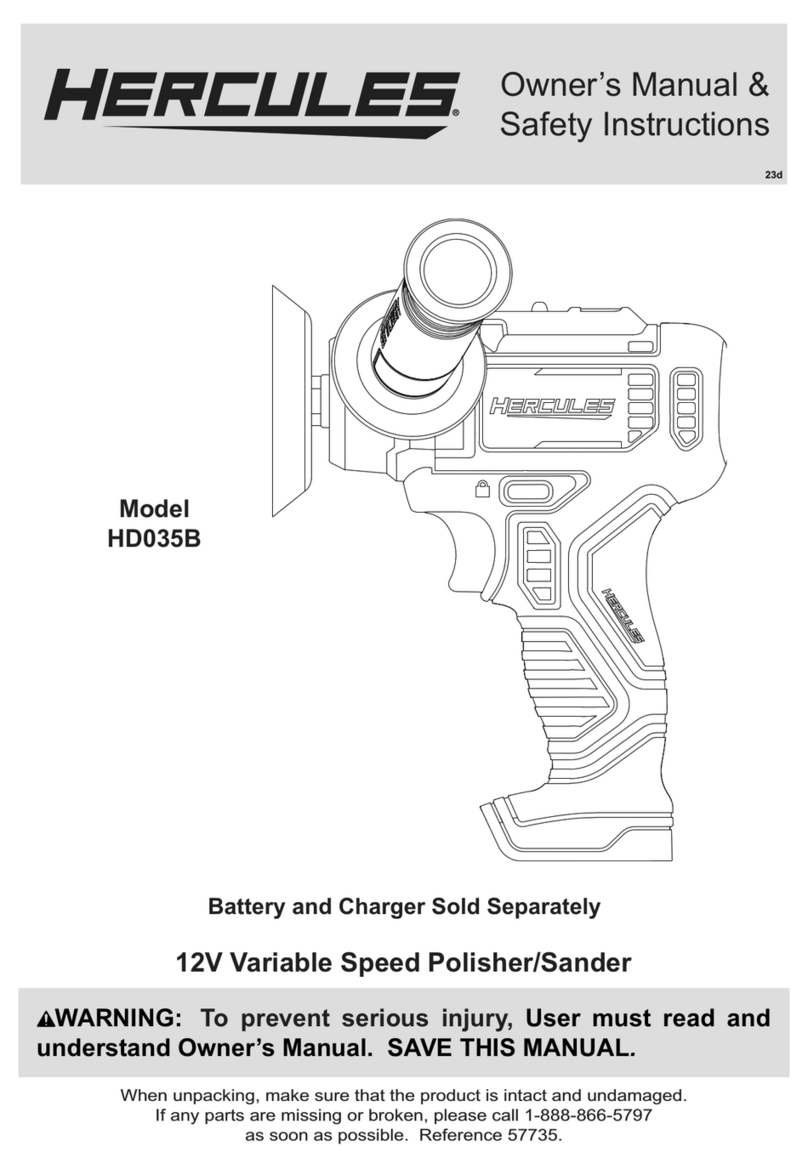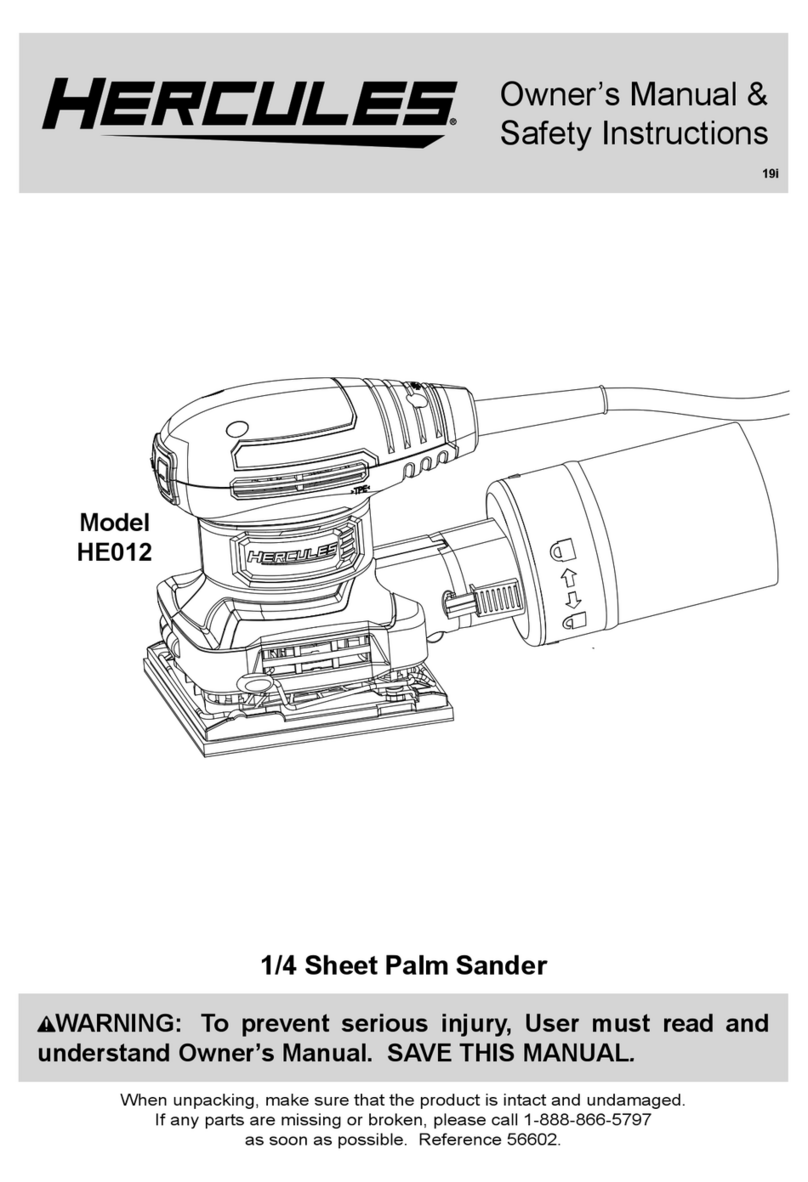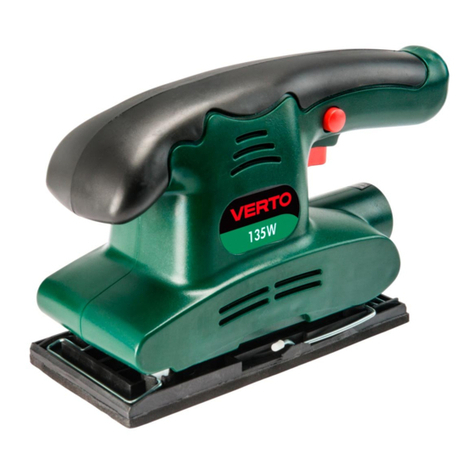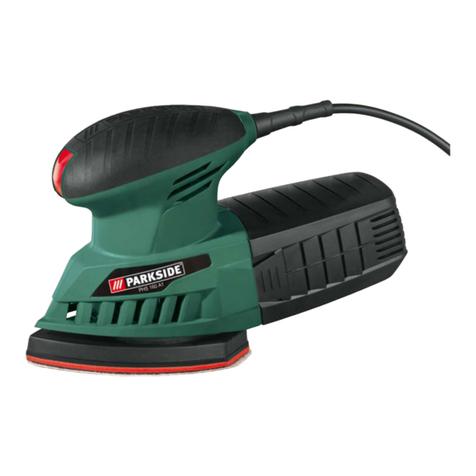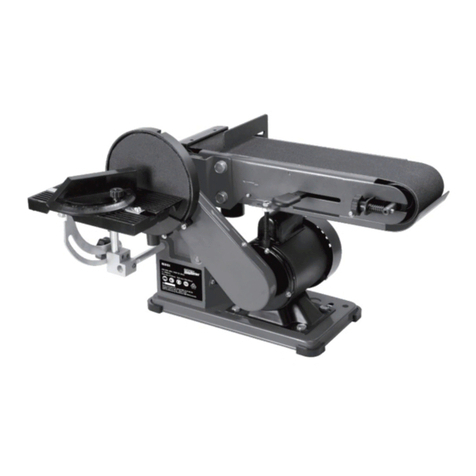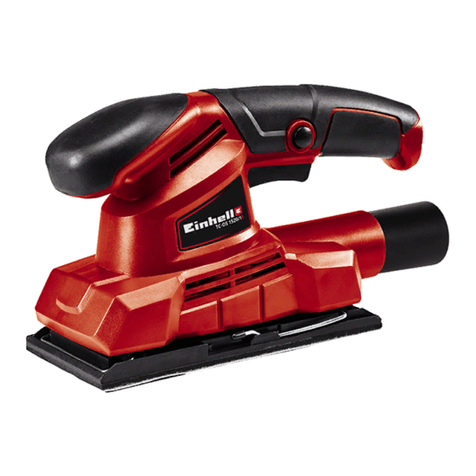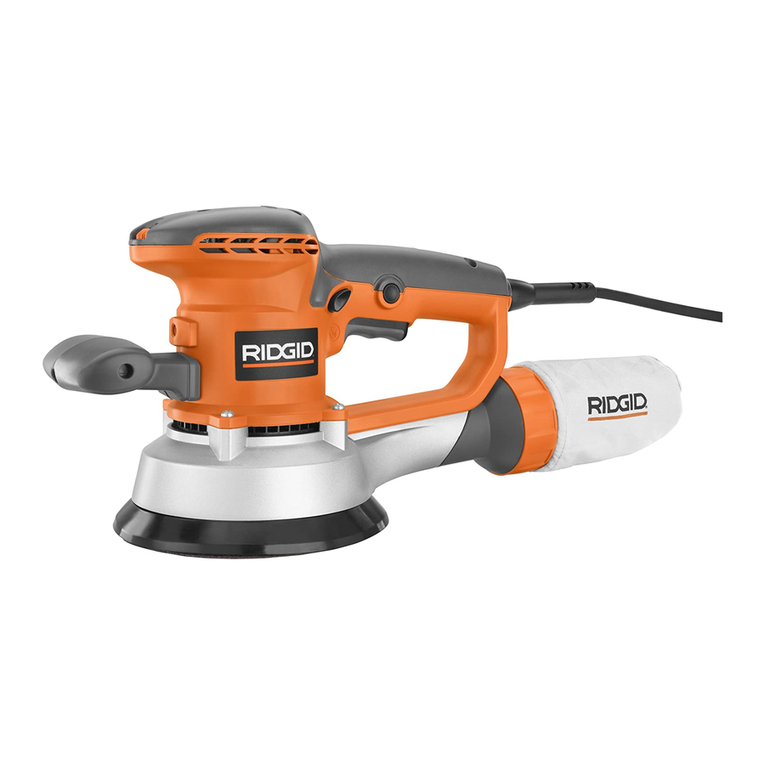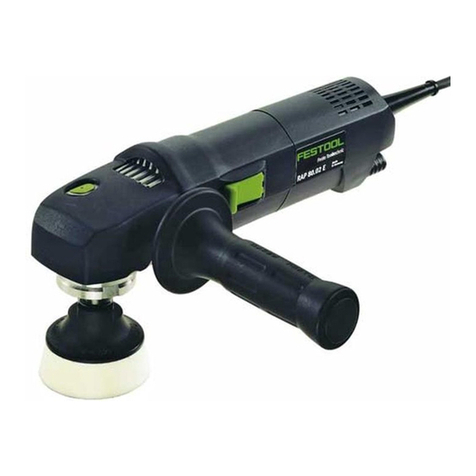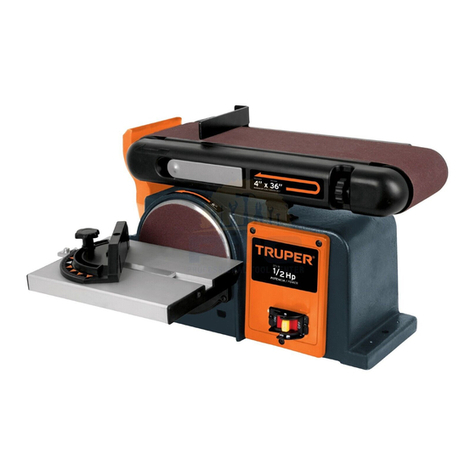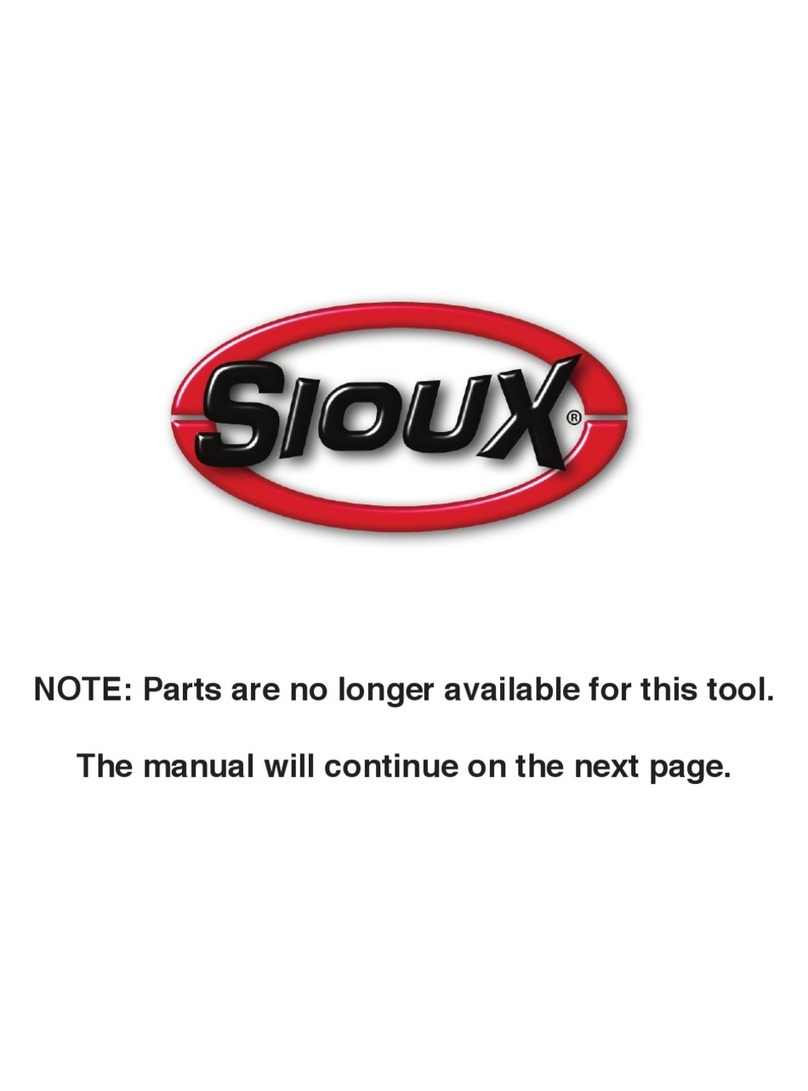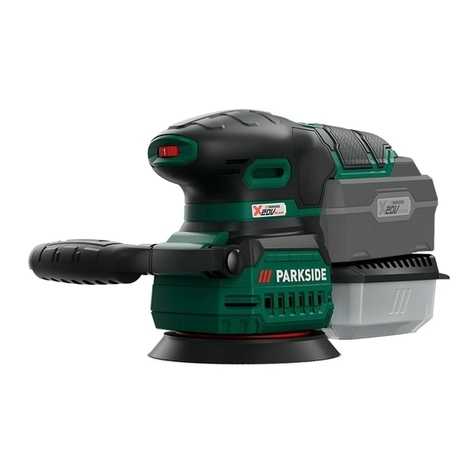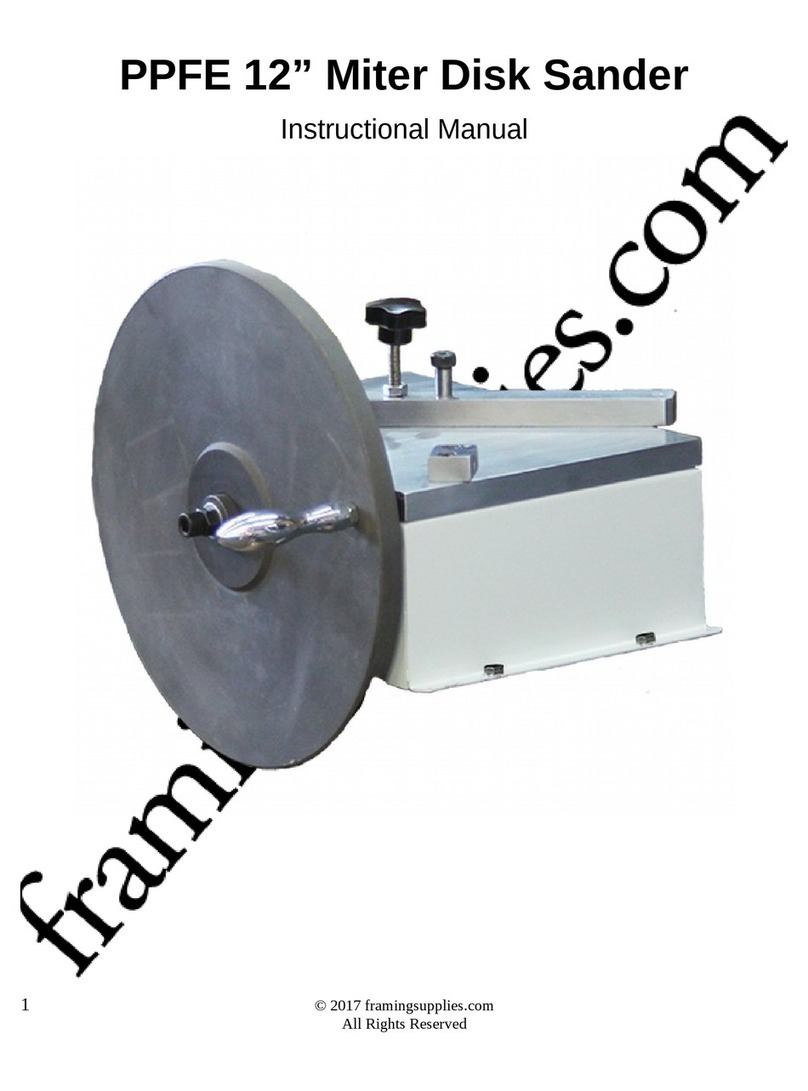Hercules HCB013B Assembly instructions

Model
HCB013B
20V Brushless 5″ Random Orbit Sander
WARNING: To prevent serious injury, User must read and
understand Owner’s Manual. SAVE THIS MANUAL.
When unpacking, make sure that the product is intact and undamaged.
If any parts are missing or broken, please call 1-888-866-5797
as soon as possible. Reference 58700.
Owner’s Manual &
Safety Instructions
22k

Page 2 For technical questions, please call 1-888-866-5797. Item 58700
IMPORTANT SAFETY INFORMATION
GENERAL POWER TOOL SAFETY WARNING
Read all safety warnings, instructions, illustrations
and specifications provided with this power tool.
Failure to follow all instructions listed below may
result in electric shock, fire and/or serious injury.
Save all warnings and instructions
for future reference.
The term “power tool” in the warnings refers
to your mains-operated (corded) power tool
or battery-operated (cordless) power tool.
Work Area Safety
1. Keep work area clean and well lit.
Cluttered or dark areas invite accidents.
2. Do not operate power tools in explosive
atmospheres, such as in the presence of
flammable liquids, gases or dust. Power tools
create sparks which may ignite the dust or fumes.
3. Keep children and bystanders away while
operating a power tool. Distractions can
cause you to lose control.
Electrical Safety
1. Power tool plugs must match the outlet.
Never modify the plug in any way. Do not use
any adapter plugs with earthed (grounded)
power tools. Unmodified plugs and matching
outlets will reduce risk of electric shock.
2. Avoid body contact with earthed or grounded
surfaces, such as pipes, radiators, ranges
and refrigerators. There is an increased risk of
electric shock if your body is earthed or grounded.
3. Do not expose power tools to rain or wet
conditions. Water entering a power tool
will increase the risk of electric shock.
4. Do not abuse the cord. Never use the cord
for carrying, pulling or unplugging the power
tool. Keep cord away from heat, oil, sharp
edges or moving parts. Damaged or entangled
cords increase the risk of electric shock.
5. When operating a power tool outdoors,
use an extension cord suitable for outdoor
use. Use of a cord suitable for outdoor
use reduces the risk of electric shock.
6. If operating a power tool in a damp location
is unavoidable, use a ground fault circuit
interrupter (GFCI) protected supply. Use of
a GFCI reduces the risk of electric shock.
Personal Safety
1. Stay alert, watch what you are doing and use
common sense when operating a power tool. Do
not use a power tool while you are tired or under
the influence of drugs, alcohol or medication.
A moment of inattention while operating power
tools may result in serious personal injury.
2. Use personal protective equipment. Always
wear eye protection. Protective equipment
such as dust mask, non-skid safety shoes, hard
hat, or hearing protection used for appropriate
conditions will reduce personal injuries.
3. Prevent unintentional starting. Ensure the
switch is in the off-position before connecting
to power source and/or battery pack, picking
up or carrying the tool. Carrying power tools
with your finger on the switch or energizing power
tools that have the switch on invites accidents.
4. Remove any adjusting key or wrench
before turning the power tool on. A wrench
or a key left attached to a rotating part of the
power tool may result in personal injury.
5. Do not overreach. Keep proper footing and
balance at all times. This enables better control
of the power tool in unexpected situations.
6. Dress properly. Do not wear loose clothing or
jewelry. Keep your hair, clothing and gloves
away from moving parts. Loose clothes, jewelry
or long hair can be caught in moving parts.
7. If devices are provided for the connection of
dust extraction and collection facilities, ensure
these are connected and properly used. Use of
dust collection can reduce dust-related hazards.
8. Do not let familiarity gained from frequent use
of tools allow you to become complacent and
ignore tool safety principles. A careless action
can cause severe injury within a fraction of a second.
9. Only use safety equipment that has been approved
by an appropriate standards agency. Unapproved
safety equipment may not provide adequate
protection. Eye protection must be ANSI-approved
and breathing protection must be NIOSH-approved
for the specific hazards in the work area.
10. Avoid unintentional starting. Prepare to
begin work before turning on the tool.
11. Do not lay the tool down until it has come to
a complete stop. Moving parts can grab the
surface and pull the tool out of your control.
12. When using a handheld power tool,
maintain a firm grip on the tool with both
hands to resist starting torque.

Page 3For technical questions, please call 1-888-866-5797.Item 58700
13. Do not leave the tool unattended when the
Battery Pack is connected. Turn off the tool,
and remove the Battery Pack before leaving.
14. This product is not a toy.
Keep it out of reach of children.
15. People with pacemakers should consult their
physician(s) before use. Electromagnetic fields in
close proximity to heart pacemaker could cause
pacemaker interference or pacemaker failure.
16. The warnings, precautions, and instructions
discussed in this instruction manual cannot
cover all possible conditions and situations
that may occur. It must be understood by the
operator that common sense and caution are
factors which cannot be built into this product,
but must be supplied by the operator.
Power Tool Use and Care
1. Do not force the power tool. Use the correct
power tool for your application. The correct
power tool will do the job better and safer
at the rate for which it was designed.
2. Do not use the power tool if the switch
does not turn it on and off. Any power
tool that cannot be controlled with the switch
is dangerous and must be repaired.
3. Disconnect the plug from the power source and/
or remove the battery pack, if detachable, from
the power tool before making any adjustments,
changing accessories, or storing power
tools. Such preventive safety measures reduce
the risk of starting the power tool accidentally.
4. Store idle power tools out of the reach of
children and do not allow persons unfamiliar
with the power tool or these instructions
to operate the power tool. Power tools are
dangerous in the hands of untrained users.
5. Maintain power tools and accessories.
Check for misalignment or binding of moving
parts, breakage of parts and any other
condition that may affect the power tool’s
operation. If damaged, have the power tool
repaired before use. Many accidents are
caused by poorly maintained power tools.
6. Keep cutting tools sharp and clean. Properly
maintained cutting tools with sharp cutting edges
are less likely to bind and are easier to control.
7. Use the power tool, accessories and tool bits
etc. in accordance with these instructions,
taking into account the working conditions
and the work to be performed. Use of the
power tool for operations different from those
intended could result in a hazardous situation.
8. Keep handles and grasping surfaces dry, clean
and free from oil and grease. Slippery handles
and grasping surfaces do not allow for safe handling
and control of the tool in unexpected situations.
Service
1. Have your power tool serviced by a
qualified repair person using only identical
replacement parts. This will ensure that the
safety of the power tool is maintained.
2. Never service damaged BATTERY packs. Service
of BATTERY packs should only be performed by
the manufacturer or authorized service providers.
3. Maintain labels and nameplates on the tool.
These carry important safety information.
If unreadable or missing, contact
Harbor Freight Tools for a replacement.
Belt sander and drum
sander safety warnings
Hold the power tool by insulated gripping surfaces,
because the sanding surface may contact
its own cord. Cutting a “live” wire may make
exposed metal parts of the power tool “live” and
could give the operator an electric shock.
Battery tool use and care
1. Prevent unintentional starting. Ensure the
switch is in the off-position before connecting
to battery pack, picking up or carrying the
power tool. Carrying the power tool with your
finger on the switch or energizing power tool
that have the switch on invites accidents.
2. Disconnect the battery pack from the
power tool before making any adjustments,
changing accessories, or storing power tool.
Such preventive safety measures reduce the
risk of starting the power tool accidentally.
3. Recharge only with the charger specified by
the manufacturer. A charger that is suitable
for one type of battery pack may create a risk
of fire when used with another battery pack.
4. Use power tools only with specifically
designated battery packs. Use of any other
battery packs may create a risk of injury and fire.
5. When battery pack is not in use, keep it away
from other metal objects, like paper clips,
coins, keys, nails, screws or other small metal
objects, that can make a connection from
one terminal to another. Shorting the battery
terminals together may cause burns or a fire.
6. Under abusive conditions, liquid may be ejected
from the battery; avoid contact. If contact
accidentally occurs, flush with water. If liquid contacts
eyes, additionally seek medical help. Liquid ejected
from the battery may cause irritation or burns.

Page 4 For technical questions, please call 1-888-866-5797. Item 58700
7. Do not use a battery pack or power tool that
is damaged or modified. Damaged or modified
batteries may exhibit unpredictable behavior
resulting in fire, explosion or risk of injury.
8. Do not expose a battery pack or power tool to
fire or excessive temperature. Exposure to fire or
temperature above 140°F may cause explosion.
9. Follow all charging instructions and do
not charge the battery pack or power tool
outside of the temperature range specified
in the instructions. Charging improperly or at
temperatures outside of the specified range may
damage the battery and increase the risk of fire.
10. Have servicing performed by a qualified
repair person using only identical
replacement parts. This will ensure that
the safety of the product is maintained.
11. Do not modify or attempt to repair the power
tool or the battery pack except as indicated
in the instructions for use and care.
12. The battery Charger gets hot during
use. The Charger’s heat can build up to
unsafe levels and create a fire hazard if it
does not receive adequate ventilation,
due to an electrical fault, or if it is used in a
hot environment. Do not place the Charger on a
flammable surface. Do not obstruct any vents on the
Charger. Especially avoid placing the Charger on
carpets and rugs; they are not only flammable,
but they also obstruct vents under the Charger.
Place the Charger on a stable, solid, nonflammable
surface (such as a stable metal workbench or
concrete floor) at least 1 foot away from all
flammable objects, such as drapes or walls. Keep a
fire extinguisher and a smoke detector in the area.
Frequently monitor the Charger and
Battery Pack while charging.
Lithium Battery Safety Warnings
LITHIUM BATTERIES STORE
A LARGE AMOUNT OF ENERGY AND
WILL VENT FIRE OR EXPLODE
IF MISTREATED:
a. Keep Battery Pack dry.
b. DO NOT DO ANY OF THE FOLLOWING
TO THE BATTERY PACK:
• Open,
• Drop,
• Short-circuit,
• Puncture,
• Incinerate, or
• Expose to temperatures greater than 140°F.
c. Charge Battery Pack only according
to its Charger’s instructions.
d. Inspect Battery Pack before every use;
do not use or charge if damaged.
Vibration Safety
This tool vibrates during use.
Repeated or long-term exposure to vibration may
cause temporary or permanent physical injury,
particularly to the hands, arms and shoulders.
To reduce the risk of vibration-related injury:
1. Anyone using vibrating tools regularly or for an
extended period should first be examined by a
doctor and then have regular medical check-ups to
ensure medical problems are not being caused or
worsened from use. Pregnant women or people who
have impaired blood circulation to the hand, past
hand injuries, nervous system disorders, diabetes,
or Raynaud’s Disease should not use this tool.
If you feel any symptoms related to vibration (such
as tingling, numbness, and white or blue fingers),
seek medical advice as soon as possible.
2. Do not smoke during use. Nicotine reduces
the blood supply to the hands and fingers,
increasing the risk of vibration-related injury.
3. Wear suitable gloves to reduce the
vibration effects on the user.
4. Use tools with the lowest vibration
when there is a choice.
5. Include vibration-free periods each day of work.
6. Grip tool as lightly as possible (while still keeping
safe control of it). Let the tool do the work.
7. To reduce vibration, maintain the tool as
explained in this manual. If any abnormal
vibration occurs, stop use immediately.
Grounding
TO PREVENT ELECTRIC SHOCK AND
DEATH FROM INCORRECT GROUNDING:
Check with a qualified electrician if you
are in doubt as to whether the outlet is
properly grounded. Do not modify the power cord
plug provided with the charger. Do not use the
charger if the power cord or plug is damaged.
If damaged, have it repaired by a service facility
before use. If the plug will not fit the outlet,
have a proper outlet installed by a
qualified electrician.

Page 5For technical questions, please call 1-888-866-5797.Item 58700
Extension Cords
Note: Extension cords must not be
used with this item’s Charger.
Symbology
VVolts
Direct Current
AAmperes
n0xxxx/min. No Load Revolutions
per Minute (RPM)
WARNING marking concerning Risk
of Eye Injury. Wear ANSI-approved
safety goggles with side shields.
Read the manual before
set-up and/or use.
WARNING marking
concerning Risk of Fire.
Do not cover Charger
ventilation ducts.
Charge on fireproof surface only.
WARNING marking concerning
Risk of Electric Shock.
Properly connect Charger’s power
cord to appropriate outlet.
WARNING marking concerning
Risk of Explosion.
Do not puncture, short, or open
battery packs and do not charge
damaged battery packs.
Warning Symbols and Definitions
This is the safety alert symbol. It is used to
alert you to potential personal injury hazards.
Obey all safety messages that follow this symbol to
avoid possible injury or death.
Indicates a hazardous
situation which, if not
avoided, will result in death or serious injury.
Indicates a hazardous
situation which, if not
avoided, could result in death or serious injury.
Indicates a hazardous
situation which, if not
avoided, could result in minor or moderate injury.
Addresses practices not
related to personal injury.
Specifications
Battery Type Hercules 20V Li-ion
57373 (sold separately)
Charger Type Hercules Li-ion 56559
(sold separately)
No Load Speed n0: 8000 –12000/min
SETUP - BEFORE USE:
Read the ENTIRE IMPORTANT
SAFETY INFORMATION section at the
beginning of this manual including
all text under subheadings therein
before set up or use of this product.
Functional Description
1
2
3
4
5
1. Power
Switch
2. Grip
3. Speed Control
Switch
4. Dust Bag
5. Backing Pad
Assembly
1. Slide the Dust Bag onto the Dust Port at the back
of the Sander and slightly twist to lock in place.
2. The collection of the dust will only work if the
sandpaper has holes that line up with the 8 dust
collection holes in the Backing Pad. There are
3 other holes in the Backing Pad for the Screws
that attach the Backing Pad to the Sander.
Charging Battery Pack
Charge battery after unpacking and before using this
tool. Follow instructions included with battery charger.

Page 6 For technical questions, please call 1-888-866-5797. Item 58700
OPERATING INSTRUCTIONS
Read the ENTIRE IMPORTANT
SAFETY INFORMATION section at the
beginning of this manual including
all text under subheadings therein
before set up or use of this product.
Workpiece and Work Area Set Up
1. Workpiece selection:
a. Workpiece must be free of foreign objects.
b. Wear a NIOSH-approved respirator and
have appropriate ventilation whenever
sanding pressure treated lumber.
2. Designate a work area that is clean and well lit.
The work area must not allow access by children
or pets to prevent distraction and injury.
3. Secure loose workpieces using a vise or clamps
(not included) to prevent movement while working.
4. There must not be objects, such as utility lines,
nearby that will present a hazard while working.
Tool Changing
TO PREVENT SERIOUS INJURY FROM
ACCIDENTAL OPERATION:
Make sure that the Switch is in the off-position
and remove its Battery Pack before
performing any procedure in this section.
1. The 5″ Sanding Disc (sold separately) is attached
by Hook and Loop to the Backing Pad.
2. Place the desired Sanding Disc on the
Backing Pad, lining up the 8 holes so that
the dust can be collected into the Dust Bag.
Press the Sanding Disc firmly in place.
Setting and Testing
1. Ensure the sanding paper is correctly attached
to the Sander and that its holes align with the
holes in the Backing Pad so the Dust Bag will
collect debris during the sanding operation.
2. Switch the Power Switch to ON (I) and
run the tool for at least 30 seconds.
3. If abnormal noise/vibration occurs or the
sandpaper slips off, have the problem
corrected before further use.
General Instructions for Use
TO PREVENT SERIOUS INJURY:
Grip the tool firmly with both hands.
1. Make sure that the Power Switch is in the
off-position, then attach the Battery Pack.
2. Hold the Sander by the Grip.
3. Wipe the work surface clean of all dirt and
debris, especially that of previous coarser
sanding sessions which will scratch the
surface of a finer grit sanding session.
CAUTION! The tool will restart automatically if stalled.
4. To start, grip the tool firmly with both hands and
press the “I” on the Power Switch. Press the
“O” on the Power Switch to stop the tool.
5. The speed of the Sander may be varied by turning
the Speed Control Switch. Wait until the tool has
reached full speed then gently contact the surface.
6. Keep heavy pressure off the tool when
operating. Allow the tool to do the work.
7. Move the tool in a uniform pattern up and down or
side to side while sanding to ensure even sanding.
8. Periodically, turn off the tool and check for disc
wear. Replace worn Sanding Discs as needed.
9. WARNING! SANDING DUST FROM SURFACE
COATINGS CAN SELF-IGNITE. To prevent
serious injury and death from fire, empty bag
frequently (at least every 10 minutes) during use
and immediately after use. Put dust in a metal
can with an airtight lid, and remove dust from
premises daily. Keep a fully charged class ABC
fire extinguisher in the vicinity of the work area.
10. To prevent accidents, turn off the tool after use.
CAUTION! Allow the tool to come to a compete
stop before setting it down.
Unplug the tool. Clean, then store the
tool indoors out of children’s reach.
Record Product’s Serial Number Here:
Note: If product has no serial number, record month and year of purchase instead.
Replacement parts may be available for this item.
Visit harborfreight.com/parts for a list of in-stock parts Reference UPC 193175444462.

Page 7For technical questions, please call 1-888-866-5797.Item 58700
Maintenance and Servicing
Instructions
Procedures not specifically explained
in this manual must be performed
only by a qualified technician.
TO PREVENT SERIOUS INJURY FROM
ACCIDENTAL OPERATION:
Make sure that the Switch is in the off-position
and remove its Battery Pack before
performing any procedure in this section.
TO PREVENT SERIOUS INJURY FROM TOOL
FAILURE:
Do not use damaged equipment.
If abnormal noise or vibration occurs, have
the problem corrected before further use.
Cleaning, Maintenance,
and Lubrication
1. BEFORE EACH USE, inspect the general
condition of the tool. Check for:
• leaking, swollen, or cracked battery pack,
• loose hardware,
• misalignment or binding of moving parts,
• cracked or broken parts, and
• any other condition that may
affect its safe operation.
2. AFTER USE, empty Dust Bag and wipe
external surfaces of the tool with clean cloth.
3. Periodically, wear ANSI-Approved safety goggles
and NIOSH-approved breathing protection and blow
dust out of the motor vents using dry compressed air.
4. Disconnect battery pack and store battery pack,
charger, and tool in dry, indoor area out of
reach of children and away from metal objects
(i.e., paperclips, coins) to prevent shorting.
5. Li-Ion BATTERY MUST BE RECYCLED
OR DISPOSED OF PROPERLY. Do not
short, incinerate or open battery.
Troubleshooting
Problem Possible Causes Likely Solutions
Tool will not start. 1. Battery Pack not properly
connected.
2. Battery Pack not properly
charged.
3. Battery Pack burnt-out.
4. Internal damage or wear.
( Switch, for example.)
1. Remove Battery Pack, make sure there are no
obstructions, reinsert the Battery Pack according
to its shape (it should only fit one way), and press
firmly until the Battery Pack locks in place.
2. Make sure Charger is connected and
operating properly. Give enough time for
Battery Pack to recharge properly.
3. Dispose of old Battery Pack
properly or recycle. Replace Battery Pack.
4. Have technician service tool.
Tool operates slowly. 1. Excess pressure applied
to workpiece.
2. Battery Pack power low.
3. Battery Pack burnt-out.
1. Decrease pressure, allow tool to do the work.
2. Recharge Battery Pack.
3. Dispose of old Battery Pack
properly or recycle. Replace Battery Pack.
Excessive noise
or rattling.
Internal damage or wear.
( Bearings, for example.)
Have technician service tool.
Overheating. 1. Forcing tool to work too fast.
2. Blocked motor housing vents.
1. Allow tool to work at its own rate.
2. Wear ANSI-approved safety goggles and NIOSH-
approved dust mask/respirator while blowing
dust out of motor using compressed air.
Tool does not
grind, sand or
brush effectively.
Accessory damaged, worn or
wrong type for the material.
Check condition and type of disc accessory. Use
only proper type of disc accessory in good condition.
Follow all safety precautions whenever diagnosing or servicing
the tool. Disconnect power supply before service.

26677 Agoura Road • Calabasas, CA 91302 • 1-888-866-5797
5-YEAR LIMITED WARRANTY
This Hercules tool is warranted to the original purchaser to be free from defects in materials and
workmanship for a period of five (5) years beginning on the date of purchase. This warranty does not
cover battery packs and battery chargers, which are covered under separate warranties. To obtain
warranty service, visit your local Harbor Freight retail store. Warranty registration is not required. The
product or part must be returned to us with proof of purchase (e.g. in-store receipt or packing slip/invoice)
and may require shipment by purchaser to a service center at purchaser’s expense. If our inspection
verifies a covered defect in materials or workmanship during the warranty period, we will, at our option,
repair or replace the defective product. We will return repaired products within a reasonable time at our
expense, but if we determine that there is no defect, or that the defect resulted from causes not within
the scope of our warranty, then we will return the product to you if you pay return shipping costs.
This warranty does not cover any failure or damage that we determine is due directly or indirectly
to normal wear and tear, misuse, use not for the intended purpose or not in accordance with the
product manual, abuse, accident, rental, modification or alteration, unauthorized repair, improper
installation, neglect, lack of maintenance, or any other failure not arising from defective materials or
workmanship. Fraudulent returns or claims will be denied. The repair or replacement described in this
warranty shall be your sole and exclusive remedy. THIS WARRANTY IS EXCLUSIVE AND IN LIEU
OF ALL OTHER EXPRESS WARRANTIES, WRITTEN OR ORAL, AND ANY IMPLIED WARRANTIES
ARE DISCLAIMED TO THE EXTENT PERMITTED BY LAW AND OTHERWISE LIMITED TO THE
DURATION OF THE EXPRESS WARRANTY HEREIN. HARBOR FREIGHT SHALL NOT BE LIABLE
UNDER ANY CIRCUMSTANCES FOR ANY INCIDENTAL, INDIRECT, SPECIAL, CONSEQUENTIAL,
OR PUNITIVE DAMAGES OR COSTS ARISING FROM THIS WARRANTY OR THE USE OF THIS
PRODUCT. SOME STATES DO NOT ALLOW LIMITATIONS ON HOW LONG AN IMPLIED WARRANTY
LASTS OR THE EXCLUSION OR LIMITATION OF INCIDENTAL OR CONSEQUENTIAL DAMAGES, SO
THESE LIMITATIONS MAY NOT APPLY TO YOU. THIS WARRANTY GIVES YOU SPECIFIC LEGAL
RIGHTS, AND YOU MAY ALSO HAVE OTHER RIGHTS WHICH VARY FROM STATE TO STATE.
Visit our website at: http://www.harborfreight.com
For technical questions, please call 1-888-866-5797
Copyright©2022 by Harbor Freight Tools®. All rights reserved. No portion of this manual or
any artwork contained herein may be reproduced in any shape or form without the express
written consent of Harbor Freight Tools. Diagrams within this manual may not be drawn
proportionally. Due to continuing improvements, actual product may differ slightly from the
product described herein. Tools required for assembly and service may not be included.
Table of contents
Other Hercules Sander manuals
Popular Sander manuals by other brands
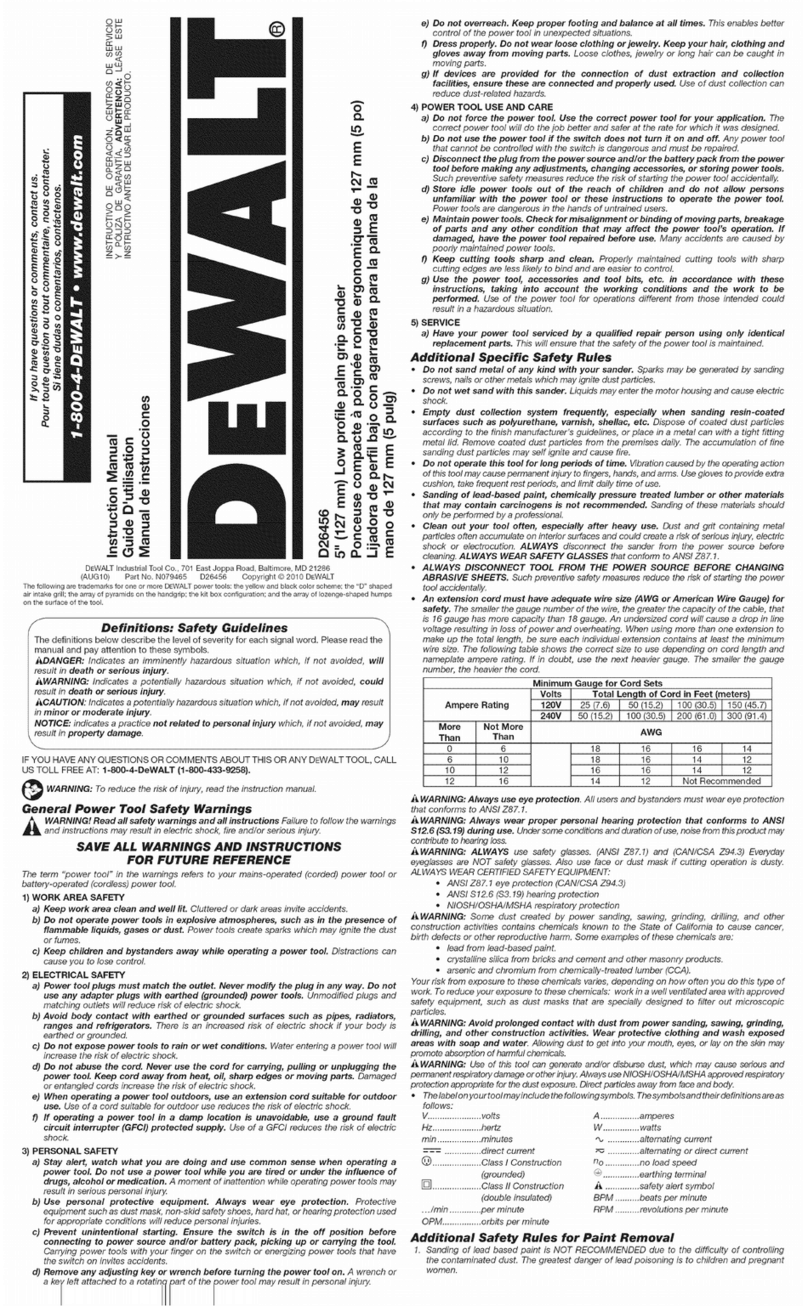
DeWalt
DeWalt D26456 instruction manual

Bosch
Bosch PSS 190 AC Original instructions
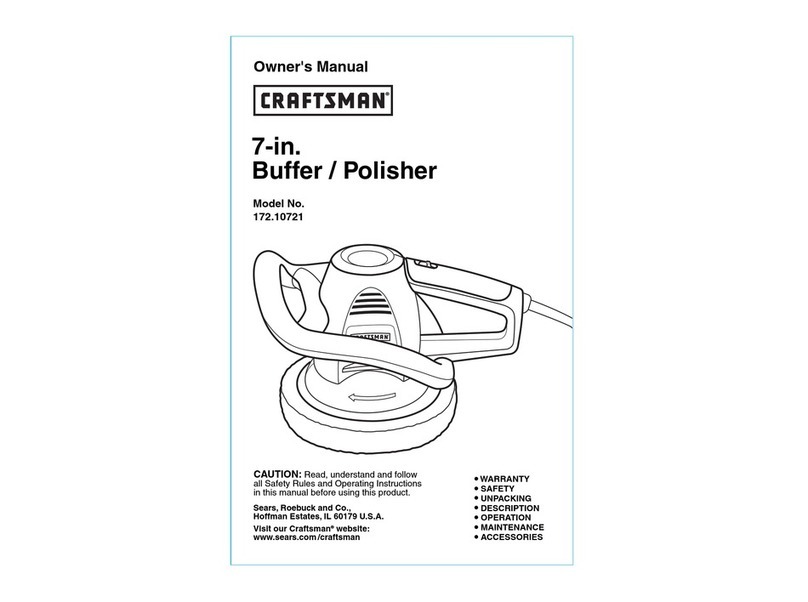
Craftsman
Craftsman 7-IN. BUFFER / POLISHER 172.10721 owner's manual
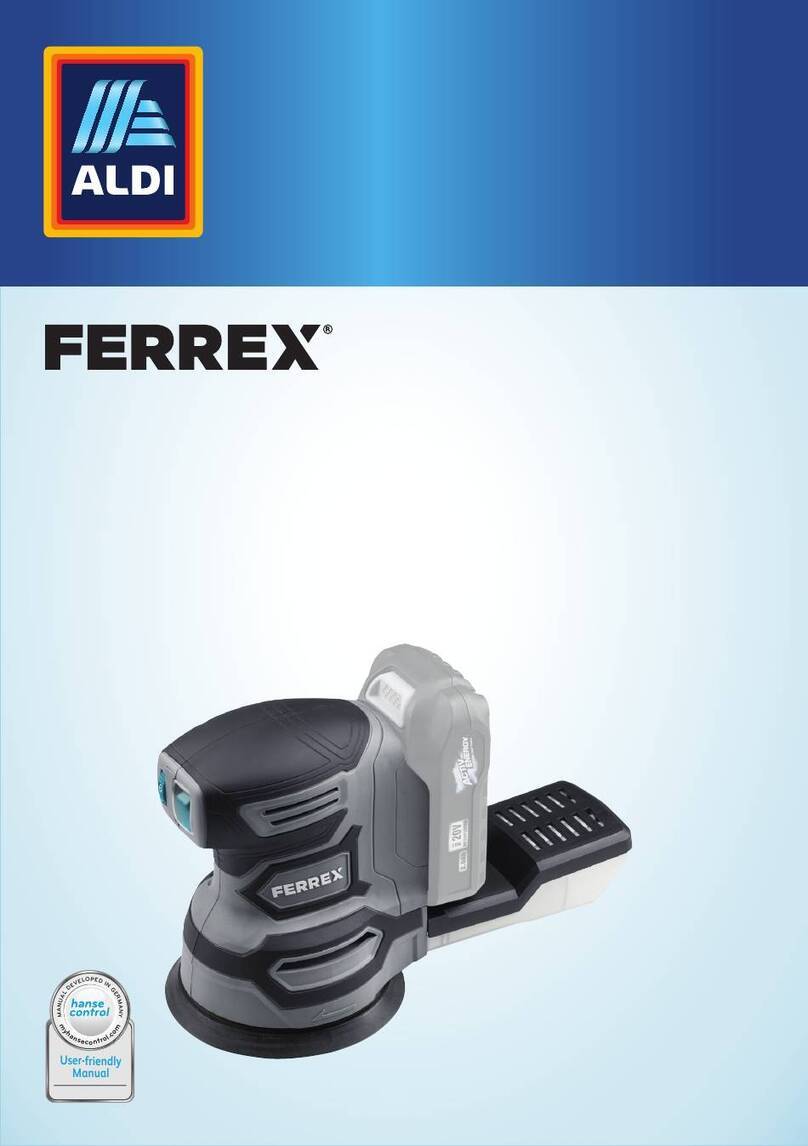
FERREX
FERREX FAES 20-I user manual
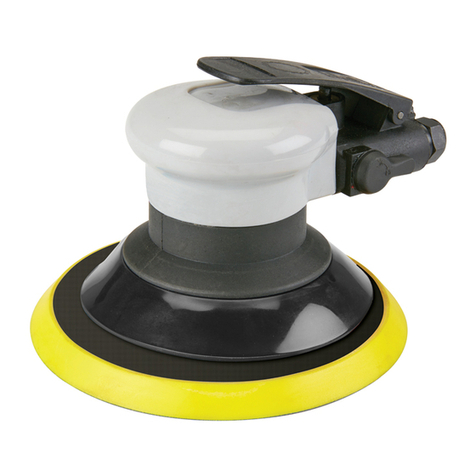
Harbor Freight Tools
Harbor Freight Tools Central Pneumatic Professional 93867 Assembly and operating instructions
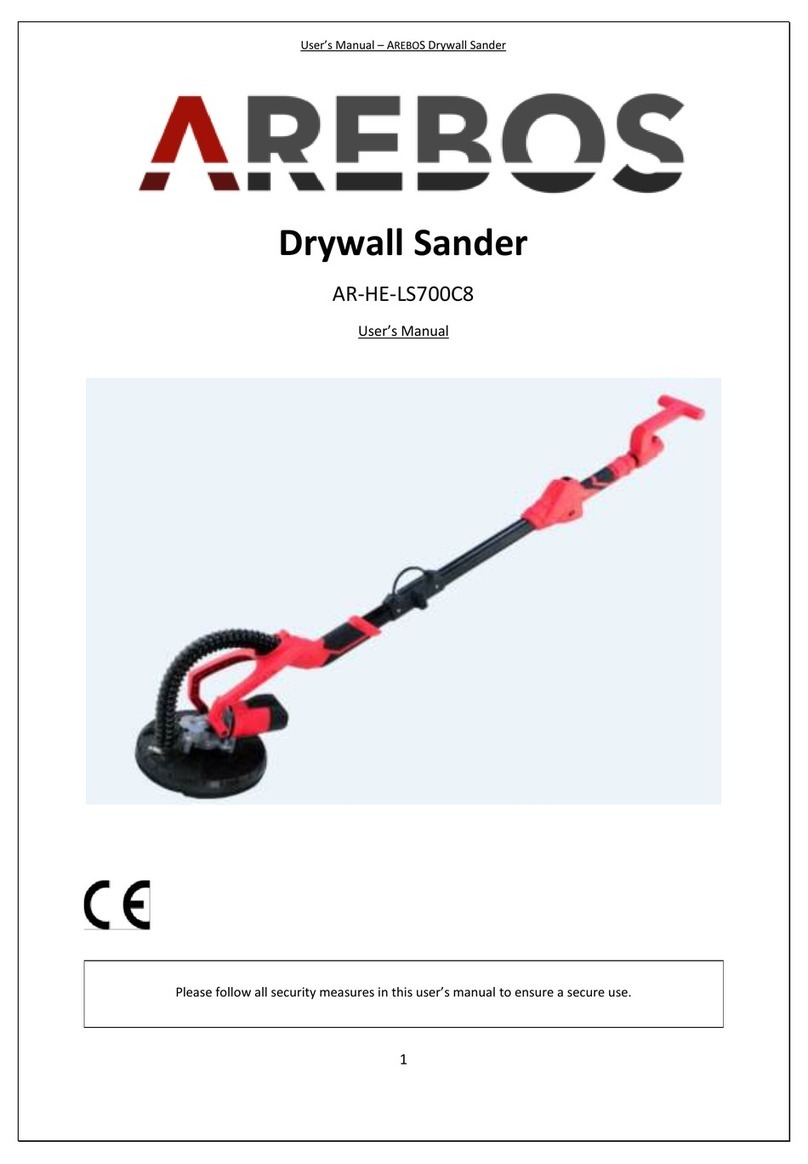
AREBOS
AREBOS AR-HE-LS700C8 user manual

